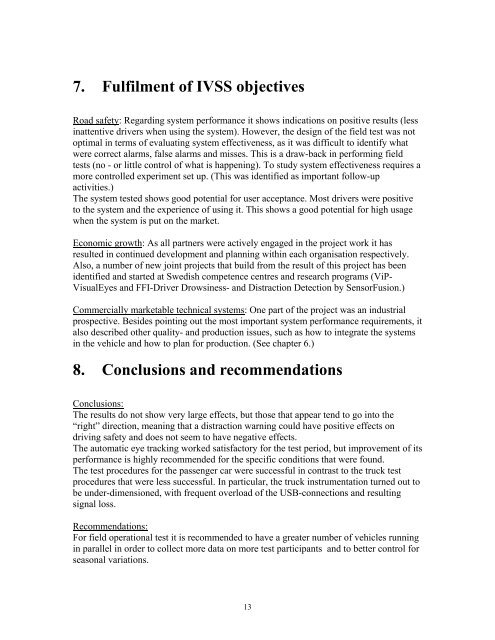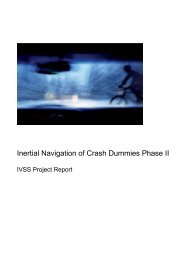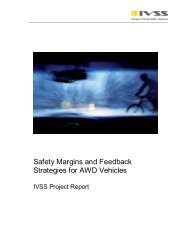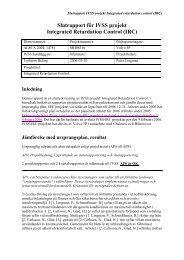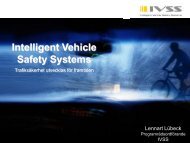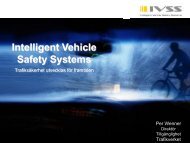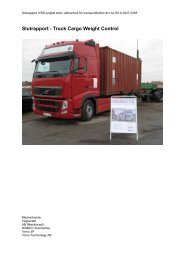7. Fulfilment of IVSS objectives - IVSS Intelligent Vehicle Safety ...
7. Fulfilment of IVSS objectives - IVSS Intelligent Vehicle Safety ...
7. Fulfilment of IVSS objectives - IVSS Intelligent Vehicle Safety ...
Create successful ePaper yourself
Turn your PDF publications into a flip-book with our unique Google optimized e-Paper software.
<strong>7.</strong> <strong>Fulfilment</strong> <strong>of</strong> <strong>IVSS</strong> <strong>objectives</strong><br />
Road safety: Regarding system performance it shows indications on positive results (less<br />
inattentive drivers when using the system). However, the design <strong>of</strong> the field test was not<br />
optimal in terms <strong>of</strong> evaluating system effectiveness, as it was difficult to identify what<br />
were correct alarms, false alarms and misses. This is a draw-back in performing field<br />
tests (no - or little control <strong>of</strong> what is happening). To study system effectiveness requires a<br />
more controlled experiment set up. (This was identified as important follow-up<br />
activities.)<br />
The system tested shows good potential for user acceptance. Most drivers were positive<br />
to the system and the experience <strong>of</strong> using it. This shows a good potential for high usage<br />
when the system is put on the market.<br />
Economic growth: As all partners were actively engaged in the project work it has<br />
resulted in continued development and planning within each organisation respectively.<br />
Also, a number <strong>of</strong> new joint projects that build from the result <strong>of</strong> this project has been<br />
identified and started at Swedish competence centres and research programs (ViP-<br />
VisualEyes and FFI-Driver Drowsiness- and Distraction Detection by SensorFusion.)<br />
Commercially marketable technical systems: One part <strong>of</strong> the project was an industrial<br />
prospective. Besides pointing out the most important system performance requirements, it<br />
also described other quality- and production issues, such as how to integrate the systems<br />
in the vehicle and how to plan for production. (See chapter 6.)<br />
8. Conclusions and recommendations<br />
Conclusions:<br />
The results do not show very large effects, but those that appear tend to go into the<br />
“right” direction, meaning that a distraction warning could have positive effects on<br />
driving safety and does not seem to have negative effects.<br />
The automatic eye tracking worked satisfactory for the test period, but improvement <strong>of</strong> its<br />
performance is highly recommended for the specific conditions that were found.<br />
The test procedures for the passenger car were successful in contrast to the truck test<br />
procedures that were less successful. In particular, the truck instrumentation turned out to<br />
be under-dimensioned, with frequent overload <strong>of</strong> the USB-connections and resulting<br />
signal loss.<br />
Recommendations:<br />
For field operational test it is recommended to have a greater number <strong>of</strong> vehicles running<br />
in parallel in order to collect more data on more test participants and to better control for<br />
seasonal variations.<br />
13


